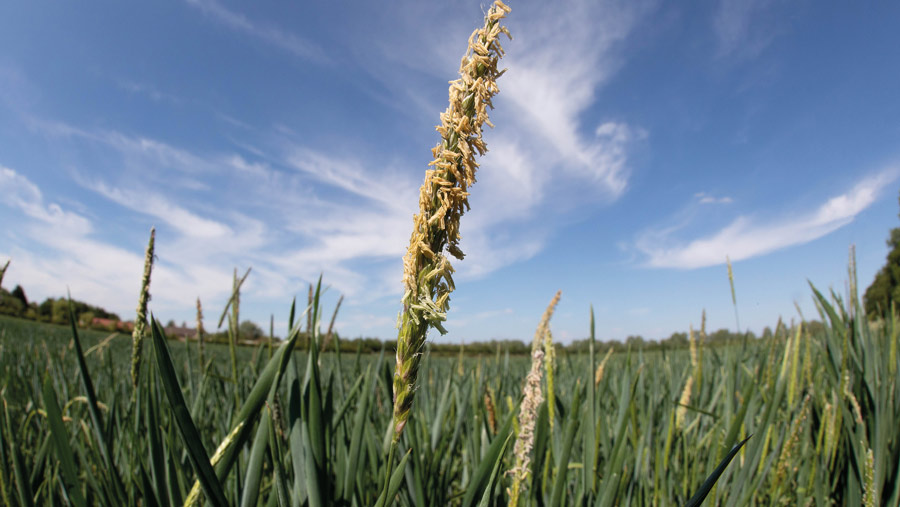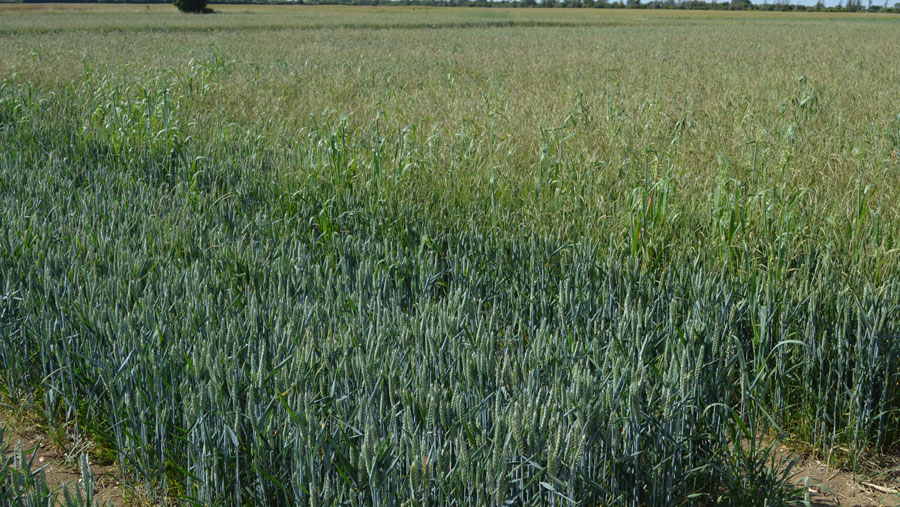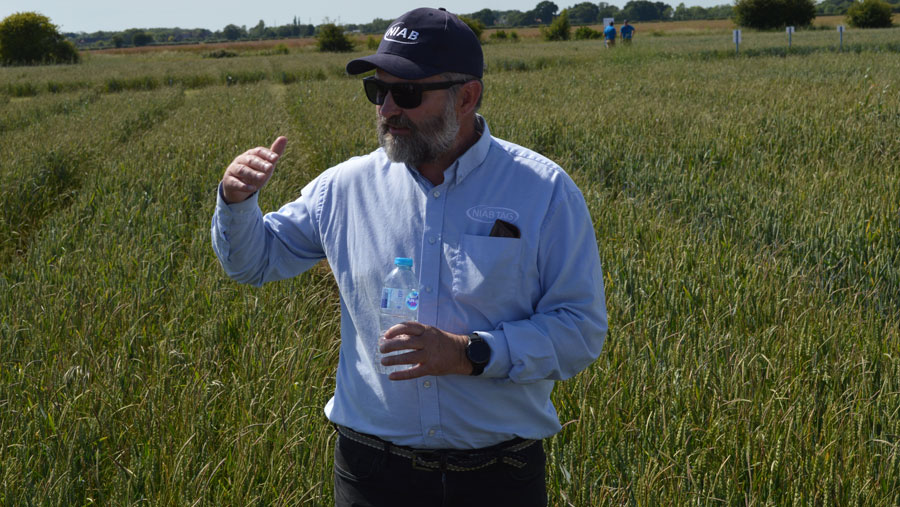Optimism for blackgrass control grows with new herbicide Luximo
 © Tim Scrivener
© Tim Scrivener Blackgrass control is set to become easier to achieve this autumn in winter wheat with the launch of the first new mode of action herbicide for decades, which outperforms the industry standard and will help tackle resistant grassweeds.
Manufacturers BASF received approval for its new active Luximo in Britain earlier this month and it is expected to be widely available this autumn, and although likely to be priced higher than existing products it gives better control than widely use flufenacet.
Steve Dennis, the agrochemical giant’s head of business development, says the new soil residual active can be used in wheat at the pre- and early post-emergence stage, and gives 78% control of blackgrass compared with just 58% for flufenacet. It gives an even bigger advantage for Italian ryegrass control.
“This is a new mode of action active which gives a more than 20% uplift against the best single active flufenacet,” he told a product launch briefing.
See also: Contractor invests in Zurn Top Cut Collect blackgrass harvester
Fight against resistant blackgrass
Resistant blackgrass costs English growers more than £400m annually, so the new active will be crucial in the fight against this resistance.
The company sees the new product as an eventual replacement for flufenacet, which can struggle to control resistant grassweeds.
The product will be available as Luxinum Plus in a co-pack with Stomp Aqua. The former delivers 500g/ha of the active cinmethylin (Luximo) and the latter 900g/ha of pendimethalin for the grower to mix in the sprayer tank. That translates to 0.7litres/ha of Luximo and 2litres/ha of Stomp Aqua.
The group declined to put a price on the new product, but said when compared with a benchmark pre-emergence mix of flufenacet, pendimethalin and diflufenican (DFF) (Crystal plus Hurricane) costing £50/ha, the Luximo combination would have an “innovation performance premium”.
In the classification of mode of actions of major grassweed herbicide, tri-allate (Avadex), flufenacet and prosulfocarb (Defy) are similar, while pendimethalin and DFF are in two different groups, and Luximo is in a different group altogether.
Outperforms flufenacet
Stuart Kevis, the group’s herbicide business development manager, who has worked with the new product for 10 years, says it has always outperformed flufenacet in heavy and low blackgrass situations and across a range of soil types.
He added that Luximo with pendimethalin gives a similar level of control to a complex sequence of a tri-allate-flufenacet-pendimethalin-DFF treatment. He said that wheat drilling should be to a 3cm depth and growers should look to close up the drilling slot to prevent herbicide going directly onto the wheat seed.
“The best position for Luximo is in the pre-emergence slot as its performance drops off at the peri- and post-emergence stages,” he said.
Application timing can be from pre-emergence up to GS30 in the spring, with pre-emergence the preferred timing. As well as blackgrass and ryegrass, Luximo also controls annual meadow grass and poppy.

Wheat treated with Luximo © MAG/David Jones
Don’t forget cultural controls
John Cussans, weed expert at crop consultant Niab, welcomes the new active introduction, which will help in the fight against blackgrass, but reminds growers not to forget cultural methods such as delayed autumn drilling and spring cropping in the battle to control the grassweed.
“It’s a new mode of action, so it give us something different, and for ryegrass is it is important because of flufenacet resistance,” he said.
The active cinmethylin was first discovered in the 1970s but was then too costly to produce and only one batch was made for use on rice in Asia.
It was then “put back on the shelf” and forgotten about until it was later screened for blackgrass in European conditions with positive results.
Approval from the Chemicals Regulation Division (CRD) means that Britain is the second country in the world to be using Luximo after Australia, with the product still awaiting approval in the European Union.
The next approval is likely to be a Luximo-pendimethalin ready-mixed product.
Rob Gladwin, the agrochemical company’s head of technical management for agricultural products for the UK and Ireland says Luximo is the first wholly CRD-managed active substance approval gained by any manufacturer since crop protection regulation was repatriated following Brexit, and comes 21 years after flufenacet was first approved in the UK.
Farmers’ views
Essex grower Ed Ford has been using Luximo for two years on a trial basis, and believes it gives him added flexibility in the fight against blackgrass, which is already under very close control on his heavy soils.
The Ford family farms 1,200ha, with 600ha at Childerditch Farms, near Brentwood, while the rest is lighter land in Bedfordshire, and he spends up to £15,000/year on hand rogued blackgrass across the 300-350ha of wheat he grows on the Essex farm.
His wheat is all direct drilled and the average blackgrass herbicide cost on the farm is about £95/ha including Avadex, Crystal and Hurricane, and he believes the use of Luximo will help improve control.
“Luximo gives us more flexibility with timing – both for drilling and spraying. We have 99% control of blackgrass, but this is not enough. We need 100% and Luximo can help,” he said.
Northamptonshire grower Andrew Pitts says the better control offered by Luximo could actually cut costs, as a more effective pre-emergence herbicide may rule out a post-emergence spray on the 800ha of land he farms at The Grange, Mears Ashby, between Northampton and Wellingborough.
He is already controlling blackgrass by rotation, delayed drilling, spring cropping, using high seed rate and good drainage, and says better blackgrass control across his 400ha of winter wheat could allow him to grow a second successive wheat seed crop of the same variety.
Mr Pitts has not used Luximo on the farm, but he says using the best chemistry at the best timing could mean that no follow up treatment would be needed.
“It could help us streamline our blackgrass control and lead to us spending less by missing out an early post emergence,” he said.
Cultural control

John Cussans © MAG/David Jones
John Cussans of Niab says a one month delay in drilling can bring a 50-60% reduction in blackgrass density in winter wheat, and warns growers that they are “not going to spend their way out of the blackgrass problem”.
He says every week of delaying drilling can help reduce the reliance on a basket of pre-emergence products, and adds that a September drilled crop with 450 blackgrass plants/sq m can be reduced to under 100 plants/sq m simply by delaying drilling until October.
“If you are drilling winter wheat with 1,000 blackgrass plants per square metre then you will have to spend £120/ha before you see any effect on the blackgrass,” he said.
Will Smith, senior trials manager also at Niab, says that although inter-row cultivation is not an adequate single tool to give good control of blackgrass, when used alongside herbicides it can give useful control.
He said two passes in the spring with an inter-row hoe could give 30-40% control, at a cost per pass of about £15-20/ha, and allied with a herbicide regime can give very good control levels.
“Inter-row cultivations used in conjunction with herbicides can improve overall weed control,“ he said.
Widely used blackgrass herbicides |
| Avadex – tri-allate |
| Crystal – flufenacet + pendimethalin |
| Defy – prosulfocarb |
| Hurricane – diflufenican |
| Liberator – flufenacet + diflufenican |
| Luxinum Plus – cinmethylin |
| Stomp Aqua – pendimethalin |

